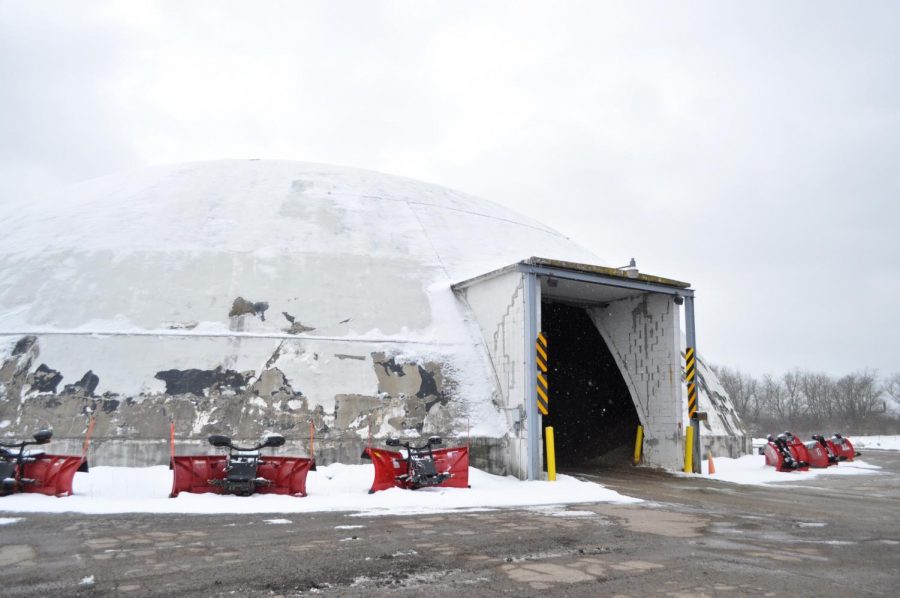What lies underneath the surface of funding and fixing of Michigan’s potholes
Driving up the highway from Monroe County to Zeeb Road, Emily Kizer chugs along I-94, keeping an eye out for pesky cavities in the road. These craters – which can be as deep enough to halt cars and cause tire damage – are the annual products of heavy Michigan winters: potholes.
While she can slow down or swerve to steer clear of these ditches, Kizer cannot avoid them when she’s off the road, where she works as the communications coordinator for the Washtenaw County Road Commission.
Kizer calls this time of year – from late February to March – pothole season: when the snow melts and reveals the nuisance of potholes. And 2018 looks like a year with one of the worst pothole repair seasons yet.
During the first three months of 2018, Washtenaw County snow maintenance crews have only had one weekend off. With the below-zero temperatures followed by the warm-up in January and another snowstorm in February, the freeze-thaw cycles in Michigan have been dramatic and unpredictable, causing the road commission crews to switch from pothole-patching to snow clean-up in a matter of hours. Any moisture – like rain or the slightest bit of snow – delays all possible patching.
“Just that back and forth is really difficult for our roads to handle,” Kizer said. “We’re trying to get through that quick transition between winter season and pothole season, and this year it has overlapped.”
The most common fix for the potholes that appear during this time of year is cold patch – asphalt that can be shoveled into a pothole in mere minutes by a two-man crew. During the last week of February, an average of 38 tons of coal patch were used each day by the Washtenaw Road Commission Operations Department, which is made up of 85 people: the laborers, crews, and foremen you see on the streets. In contrast, Wayne County, which has more miles of road, used an average of 250 tons a day.
But how does the commission decide which potholes are fixed when and where?
“It’s easy to think it’s like a random act of God,” Kizer said.
However, the process itself is pretty straightforward: there are two ways potholes can get reported.
One is through the citizens who spot them with phone calls or online reports, which go directly to the crew and foreman in that specific ‘district.’ The second way potholes are reported is by the crew and foremen themselves, who predict where potholes are likely to form because of their familiarity with their own districts. Usually, it is a simultaneous combination of both methods to reach the more than thousands of potholes the crews need to repair as fast as possible.
The part that becomes muddy is how funding goes towards road repair – or really, how it doesn’t.
The fiscal budget for pothole repairs on Michigan’s trunklines (Michigan’s highways like I-94, I-23, M-14) stood at 8.1 million dollars, according to the Michigan Department of Transportation. This is an increase from the 7.7 million in 2016, but an overall decrease compared to the 10 million spent in 2014.
Kizer argues that the budget for road repair in Michigan has not kept up with the price of inflation and has been historically low, resulting in only temporary pothole fixes like the cold patching that may last only one winter. This method acts as a “band-aid” instead of a permanent fix for the roads.
“Per person, we’re one of the lowest funded states in the country,” Kizer said. “Just to compare to Ohio, they have about the same miles of road that we do, but they spend over a billion dollars more, and have for a number of years. There’s a very clear reason why Ohio seems like they have better roads.”
In hopes of solving the problems in short-term repair, the road commission launched a four-year millage plan in 2016, asking the voters of Washtenaw County if they would be willing to have part of their property tax go to road repair. Before this plan, only user tax – which included things like license fee taxes and fuel taxes – went toward road repair. Fortunately for the Road Commission, an overwhelming 71 percent of voters approved this measure. Plans using tax money toward road repair are now being implemented throughout multiple counties in Michigan.
“I think people are getting so frustrated that federal and state [governments] aren’t doing anything, that they’re going local,” Kizer said, also acknowledging how the new revenue might not help as much as they’d like. “We’re so far behind. It’s going to take years and years to get caught up. With winter maintenance and pothole maintenance, that’s not really healthy.”
Signs of these unhealthy repair practices become increasingly evident every year. Just in the first week of March, Kizer oversaw the entire road closing of Platt Rd. into York Township because the road was so deteriorated that foundation clay was coming up through the pothole. The method of “throw-and-go” asphalt could not nurse the road’s heavily eroded conditions this time around.
Kizer understands how irritating these road closures and dangerous potholes are to citizens of Washtenaw County. Yet it seems at this point, the only thing that can truly control the poor conditions of the roads in Michigan are the seasons and government funding.
“People are rightfully frustrated with the roads,” Kizer said. “And so are we.”










